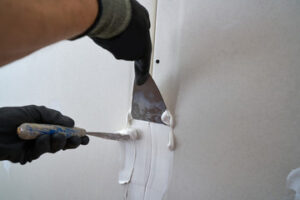Drywalls serve a variety of purposes in your home, but they can also be damaged through everyday use. Whether it’s a doorknob, a child’s toy, or a piece of furniture that dents the drywall, you need to repair the damage as soon as possible.

Fortunately, it’s not difficult to fix these dents and holes on your own using a few basic tools. But it’s important to follow the right procedure and prepare properly. However, if you want professionals to do the repair for you, then contact Drywall Repair Las Vegas.
Drywall repair is an essential skill that allows you to save money and make repairs to your home. However, you need to be prepared with the right tools for the job. These tools can help you get the job done in a timely manner and with a high level of professionalism.
The first step is to determine the type of repair you need to do. Small holes and cracks can be repaired with a putty knife, while large holes require special patching materials. If the damage is severe, you may need to use a drywall saw.
After the hole is cleaned, you can start filling it with a mix of dry-mix joint compound and water. The compound should be mixed to a smooth consistency before you apply it.
Once you’ve filled the hole, sand it until it’sit’s smooth. Then you’ll be ready to paint the wall.
There are several types of drywall screws to choose from. You should buy the type that will best suit the type of drywall you’re you’re working with. For example, coarse-thread drywall screws are great for wood studs, and fine-thread drywall screws work well with metal framing.
Another tool you should have in your drywall repair arsenal is a tape measure. This tool will help you keep track of the measurements of the areas that need to be patched.
If you’re, you’re a handyperson; you can also purchase a drywall lifter to help you elevate drywall panels an inch or so off the ground. This will reduce the risk of injury and also make the repair much easier.
Depending on the size of the hole, you can use either a pre-made drywall patch or a patch kit. These are designed to simplify the repair process and can be purchased at most hardware stores.
You can also use a roll of drywall paper to cover the hole and protect it from moisture. Alternatively, you can also use a patch that consists of an adhesive-backed aluminum screen reinforced by fiberglass mesh. This patch is ideal for repairing holes in walls, and it comes in several different sizes to meet your needs.
If you’re you’re planning on painting the interior of your home, it is imperative that you prep the drywall before you begin. This allows the paint to last longer and prevents any defects from showing once you are finished with the project. It also helps the paint adhere to the drywall better, giving you a more professional-looking result.
First, inspect the drywall for imperfections like nicks, scratches, and gouges. If you find any of these, you can use a drywall joint compound to fill them and sand the repair smoothly before painting.
Drywall is made of gypsum and is susceptible to damage from everyday wear and tear. Small nicks or scratches can be repaired with spackle, while holes require a larger repair that requires a joint drywall compound.
Next, clean the damaged areas thoroughly with soap and water or an all-purpose cleaner. Then, using a putty knife, apply a spackling paste over the affected area and let it dry.
Once the paste is fully dry, sand it with fine-mesh drywall sanding paper to create a smooth surface that is flush with the rest of the wall. Once the sanding is complete, prime the repaired area and paint it to match the rest of the wall.
In addition to repairing the drywall, it is important to prepare the wood trim, baseboards, and door frames. The right caulk and filling in gaps can help improve the look of these surfaces as well, giving you a more professional finish.
